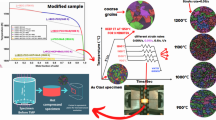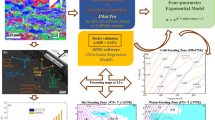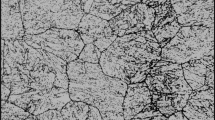Abstract
Austenitic stainless steel is known as second-generation advanced high strength steel (AHSS) due to its very high strength and elongation. The stability of austenite phase under deformation at room temperature depends on alloying elements such as Ni and Mn. Low-Ni austenitic stainless steel undergoes phase transformation, austenite to martensite, during plastic deformation. The phase transformation and crystallographic texture development are strain and strain path dependent. Consequently, material properties especially work hardening exponent (n) and normal anisotropy (\( \overline{r} \)) are altered during plastic deformation. To understand the effect of dynamic mechanical properties on the formability of low-Ni austenitic stainless steels, limiting dome height (LDH) tests were performed. Strain path diagrams (SPD) and forming limit diagrams (FLD) were plotted for this material. Finite element (FE) analyses were carried out with constant and varying (with strains and strain paths) n and \( \overline{r} \) values. The work hardening exponent was calculated for uniaxial strain path and correlated with in-grain misorientation and martensite phase fraction at different strains. This relationship is further extended to estimate the work hardening parameter for other strain paths. Strain path–dependent instantaneous \( \overline{r} \) values were determined by using bulk texture analysis. The strain path–dependent n and \( \overline{r} \) values were incorporated during FE simulation which remarkably improved the SPD and FLD predictability of low-Ni austenitic stainless steel.

















Similar content being viewed by others
References
Caballero FG, Allain S, Cornide J, Puerta Velasquez JD, Garcia-Marco C, Miller MK (2013) Design of cold rolled and continuous annealed carbide-free bainitic steels for automotive application. Mater Des 49:667–680
Post J, Datta K, Beyer J (2008) A macroscopic constitutive model for a metastable austenitic stainless steel. Mater Sci Eng A 485:290–298
Yoshida K, Tadano Y, Kuroda M (2009) Improvement in formability of aluminum alloy sheet by enhancing geometrical hardening. Comput Mater Sci 46:459–468
Mishra SK, Tiwari SM, Kumar AM, Hector LG (2012) Effect of strain and strain path on texture and twin development in austenitic steel with twinning-induced plasticity. Metall Mater Trans A 43:1598–1609
Fiorentino A (2013) Force-based failure criterion in sheet forming. Int J Adv Manuf Technol 68:557–563
Bhargava M, Tewari A, Mishra S (2013) International conference on design and manufacturing, IConDM 2013 strain path diagram simulation of AA 5182 aluminum alloy. Procedia Eng 64:1252–1258
Merklein M, Merklein M, Kuppert A, Geiger M (2010) Time dependent determination of forming limit diagrams. CIRP Annals – Manuf Tech 59:295–298
Martínez-Donaire AJ, Martínez-Donaire FJ, García-Lomas VC (2014) New approaches to detect the onset of localized necking in sheets under through-thickness strain gradients. Mater Des 57:135–145
Bhargava M, Tewari A, Mishra SK (2015) Forming limit diagram of advanced high strength steels (AHSS) basedon strain-path diagram. Mater Des 85:149–155
Uthaisangsuk V, Prahl U, Munstermann S, Bleck W (2008) Experimental and numerical failure criterion for formability prediction in sheet metal forming. Comput Mater Sci 43:43–50
Silva MB, Nielsen PS, Bay N, Martins PF (2011) Failure mechanisms in single-point incremental forming of metals. Int J Adv Manuf Technol 56:893–903
Mattiasson K, Sigvant M, Larson M (2006) Methods for forming limit prediction in ductile metal sheets. In: IDDRG 2006, Porto, Portugal, pp 1–9
Nakamachi E (1995) Sheet-forming process characterization by static-explicit anisotropic elastic–plastic finite-element simulation. J Mater Process Technol 50:116–132
Takuda H, Mori K, Takakura N, Yamaguchi K (2000) Finite element analysis of limit strains in biaxial stretching of sheet metals allowing for ductile fracture. Int J Mech Sci 42:785–798
Aretz H (2007) Numerical analysis of diffuse and localized neckingin orthotropic sheet metals. Int J Plast 23:798–840
Ganjiani M, Assempour A (2007) An improved analytical approach for determination of forming limit diagrams considering the effects of yield functions. J Mater Process Technol 182:598–607
Signorelli JW, Bertinetti MA, Turner PA (2009) Predictions of forming limit diagrams using a rate-dependent polycrystal selfconsistent plasticity model. Int J Plast 25:1–25
Hora P, Tong L, Reissner J (1996) A prediction method of ductile sheet metal failure in FE simulation. In: Numisheet Dearborn, Michigan, pp 252–256
Franz G, Abed-Meraim F, Balan T, Altmeyer G (2014) Investigation and comparative analysis of plastic instability criteria: application to forming limit diagrams. Int J Adv Manuf Technol 71:1247–1262
Nandedkar VM (2000) Formability studies on deep drawing qualitysteel. PhD thesis, IIT Bombay, Mumbai
Pilani R, Narasimhan K, Maiti SK, Singh UP, Date PP (2000) A hybrid intelligent systems approach for die design in sheet metal forming. Int J Adv Manuf Technol 16:370–375
Takuda H, Mori K, Hatta N (1999) The application of some criteria for ductile fracture to the prediction of the forming limit of sheet metals. J Mater Process Technol 95:116–121
Sing WM, Rao KP (1993) Influence of material properties on sheet metal formability limits. J Mater Process Technol 37:37–51
Franz G, Abed-Meraim F, Ben Zineb T, Lemoine X, Berveiller M (2013) Strain localization analysis for single crystals and polycrystals: towards microstructure-ductility linkage. Int J Plast 48:1–33
Yerra SK, Vankudre HV, Date PP, Samajdar I (2004) Effect of strain path on the formability of a low carbon steel—on the textural and microtextural developments. J Eng Mater Technol 126:53–61
Mishra SK, Desai SG, Pant P, Narasimhan K, Samajdar I (2009) Improved predictability of forming limit curves through microstructural inputs. Int J Mater Form 2:59–67
Uthaisangsuk V, Prahl U, Bleck W (2009) Stretch-flangeability characterisation of multiphase steel using a microstructure based failure modelling. Comput Mater Sci 45:617–623
Vadavadagi BH, Shekhawat SK, Samajdar I, Narasimhan K (2016) Forming limit curves in low-carbon steels: improved prediction by incorporating microstructural evolution. Int J Adv Manuf Technol 86:1027–1036
Bohlke T, Bondár G, Estrin Y, Lebyodkin MA (2009) Geometrically non-linear modeling of the Portevin–Le Chatelier effect. Comput Mater Sci 44:1076–1088
Xu Y, Zhang SH, Cheng M, Song HW (2012) In situ X-ray diffraction study of martensitic transformation in austenitic stainless steel during cyclic tensile loading and unloading. Scr Mater 67:771–774
Lebedev AA, Kosarchuk V (2000) Influence of phase transformations on the mechanical properties of austenitic stainless steels. Int J Plast 16:749–767
Hecker SS (1975) Simple technique for determining forming limit curves. Sheet Met Ind 52:671–675
Wang W, Wagoner RH, Wang XJ (1996) Measurement of friction under sheet forming conditions. Metall Mater Trans A 27A:3971–3981
Nowell MM, Wright SI (2005) Orientation effects on indexing of electron backscattered diffraction patterns. Ultramicroscopy. 103:41–47
Bunge HJ (1982) Texture analysis in materials science. Butterworths, London
Van Houtte P (1995) MTM-FHM software system, version 2. MTM, KU Leuven, Belgium
Van Houtte P, Li S, Seefeldt M, Delannay L (2005) Deformation texture prediction: from the Taylor model to the advanced Lamel model. Int J Plast 21:589–624
Byun TS, Lee EH, Hunn JD (2003) Plastic deformation in 316LN stainless steel- characterization of deformation microstructures. J Nucl Mater 321:29–39
Gauss C, Souza Filho IR, Sandim MJR, Suzuki PA, Ramirez AJ, Sandim HRZ (2016) In situ synchrotron X-ray evaluation of strain-induced martensite in AISI 201 austenitic stainless steel during tensile testing. Mater Sci Eng A 651:507–516
Zaefferer SS, Ohlert J, Bleck W (2004) A study of microstructure, transformation mechanisms and correlation between microstructure and mechanical properties of a low alloyed TRIP steel. Acta Mater 52:2765–2778
Zhang S, Wang P, Li D, Li Y (2015) In situ investigation on the deformation-induced phase transformation of metastable austenite in Fe–13%Cr–4% Ni martensitic stain less steel. Mater Sci Eng A 635:129–132
Banabic D, Bunge HJ, Pohlandt K, Tekkaya AE Formability of metallic material, plastic anisotropy,formability testing, forming limits. ISBN 978-3-642-08750-9
Hilkhuijsen P, Geijselaersb HJM, Borb TC (2013) The influence of austenite texture on the martensitic transformation of an austenitic stainless steel. J Alloys Compd 577:609–613
Hamada AS, Karjalainen LP, Misra RDK, Talonen J (2013) Contribution of deformation mechanisms to strength and ductility in two Cr-Mn grade austenitic stainless steels. Mater Sci Eng A 559:336–344
Acknowledgments
The EBSD and XRD at the National Facility of Texture & OIM (a DSTIRPHA facility) at IIT Bombay were used for this work. The authors would also like to acknowledge Prof. K. Narasimhan, IIT Bombay, for extending Metal Forming Laboratory facility for this work. The help provided by Mr. Jaiveer Singh and Mr. Partho Biswas is also gratefully acknowledged.
Funding
The authors received financial support from the India Science Lab, General Motors R&D, Bangalore, India.
Author information
Authors and Affiliations
Corresponding author
Additional information
Publisher’s note
Springer Nature remains neutral with regard to jurisdictional claims in published maps and institutional affiliations.
Rights and permissions
About this article
Cite this article
Chakrabarty, S., Bhargava, M., Narula, H.K. et al. Prediction of strain path and forming limit curve of AHSS by incorporating microstructure evolution. Int J Adv Manuf Technol 106, 5085–5098 (2020). https://doi.org/10.1007/s00170-020-04948-0
Received:
Accepted:
Published:
Issue Date:
DOI: https://doi.org/10.1007/s00170-020-04948-0




